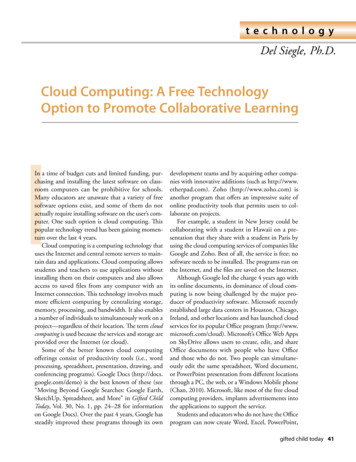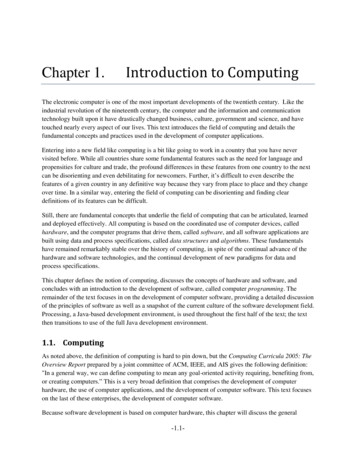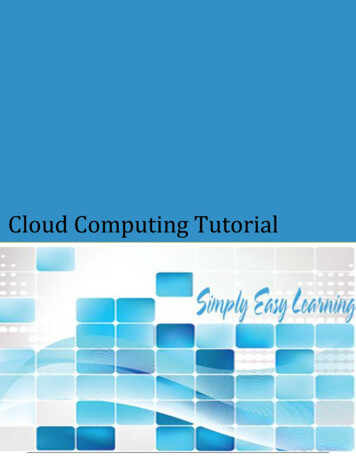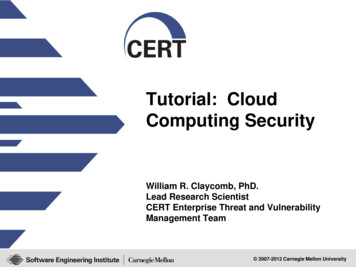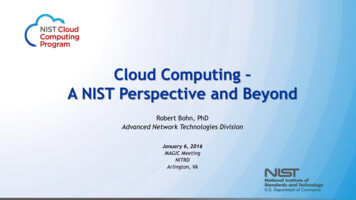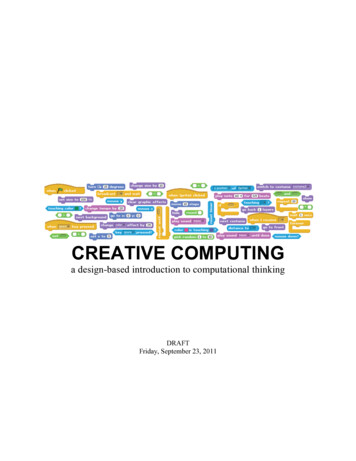
Transcription
International Journal of InnovativeComputing, Information and ControlVolume 3, Number 6(A), December 2007cICIC International 2007ISSN 1349-4198pp. 1433—1447PERFORMANCE ASSESSMENT OF COMBINATIVE PIXEL-LEVELIMAGE FUSION BASED ON AN ABSOLUTE FEATUREMEASUREMENTJiying Zhao, Robert Laganière and Zheng LiuSchool of Information Technology and EngineeringUniversity of Ottawa800 King Edward Ave., Ottawa, Ontario, Canada K1N 6N5jzhao@uottawa.caReceived December 2006; revised May 2007Abstract. In this paper, a new metric for evaluating the performance of the combinative pixel-level image fusion is defined based on an image feature measurement, i.e.phase congruency and its moments, which provide an absolute measurement of imagefeatures. By comparing the local cross-correlation of corresponding feature maps of inputimages and fused output, the quality of the fused result is assessed without a reference.The experimental results on multi-focused image pairs demonstrate the efficiency of theproposed approach.Keywords: Image fusion, Phase congruency, Feature measurement1. Introduction. The interest of using information across the electromagnetic spectrumin an image leads to the technique named image fusion. The purposes of image fusionvary with the applications. Some applications require that the image fusion can generatea composite image, which contains the complementary features available in the multipleinput images. One of the state-of-the-art techniques is multiresolution analysis (MRA)based image fusion. The input images are first represented (decomposed) in the multiresolution transform domain. Then, the sub-images (components) or transform coefficientsare combined based on certain criterion named fusion rule. The fused image is achievedby the reconstruction from the combined sub-images or coefficients. The fusion processis twofold. One is the multiresolution algorithm and the other is the fusion rule, whichguides the coefficient combination in the transform domain. The research focuses on anoptimal use of these two. A table was presented in [12] to summarize these techniques. Agood overview of the MRA-based image fusion technique can be found in reference [2, 14].While a diverse range of MRA-based fusion algorithms have been proposed, the objective assessment of the fusion results still remains a challenge, although the evaluationprocess is an application dependent issue. However, if the MRA-based pixel-level fusion isfor feature integration, we could ask a general question like, “how are the features fused?”or “how many features are available in the fused image?”. The objective and quantitative evaluation of the efficiency of the fusion algorithms has not been fully explored andaddressed so far. The assessment of fused image can be carried out in two ways. Whena perfect reference image is available, the fused image can be compared with such reference directly. The methods for image comparison can be employed, for example, root1433
1434J. ZHAO, R. LAGANIÈRE AND Z. LIUmean square error (RMSE), cross-correlation (CC), peak signal to noise ratio (PSNR),difference entropy (DE), mutual information (MI), etc. [22]. More recently, Wang et al.proposed a structural similarity (SSIM) index to compare images [21]. The SSIM indexis a simple and efficient implementation for image quality measurement. In the case offusing multi-focused image from digital camera [26], a cut and paste operation was appliedto obtain the full-focused image that served as a reference. However, such operation doesnot assure a “perfect” reference. In some applications, the ground truth can be generatedfrom more precise measurement. Unfortunately, such “prefect” reference is not availablein most applications. Therefore, the assessment has to be carried out in the absence of areference image in most situations.Qu et al. proposed using the summation of the mutual information values of input andthe fused images as an assessment metric [18]. However, the value itself does not makeany sense if there is not a reference to compare with. Xydeas et al. measured the amountof visual information transferred from the input images to the fused image [17, 23, 24, 25].The visual information is defined in terms of edge strength and orientation. The Sobeledge detector is employed to extract such information for each pixel. The Sobel edgedetection is based on the measurement of the intensity gradient, which depends on imagecontrast and spatial magnification. Therefore, one does not know in advance what level ofedge strength corresponds to a significant feature. Piella et al. defined a Q metric based onthe SSIM index [15, 16]. This metric actually calculates the weighted average of the SSIMbetween the inputs and fused images. The weighting coefficients do not clearly measurethe similarity of the input images to the fused result [4]. Cvejic et al. proposed to usethe correlation coefficients as the weighting parameters in [4]. For totally complementaryfeatures, the weighting average appears to be a good measurement. However, when thesliding window moves to the region with redundant features, this method may becomeinvalid.In this paper, a new metric based on an absolute image feature measurement is proposed. Image features are quantitatively defined and the availability of the features in thefused image is calculated as the metric to indicate the efficiency of the fusion algorithm.The rest of the paper is organized as follows. The procedure for MRA-based pixel-levelfusion is briefly described in section 2. A image fusion assessment metric is proposed insection 3. The metric is based on the image feature measurement, namely, phase congruency. Experimental results are presented in section 4. Discussion of the results and theconclusion of the paper can be found in section 5 and 6 respectively.2. Pixel-level Image Fusion. Representing an image in the transform domain makesit easier to access the image features such as edges and boundaries, which are usuallyrepresented by the larger absolute values (coefficients) in the high-frequency bands. Thefusion rule is to retain the coefficients that correspond to the most salient features. Thechoice of the kernel function that resembles the shape of the signal will result in a largerconvolution coefficient. As the input image is represented as a combination of low-,band- and high-pass sub-images (components). The simplest fusion rule is to averagethe low-pass components and retain the coefficients with larger absolute value in otherfrequency bands. The selection depends on the individual pixel herein. More sophisticatedrules will consider the surroundings of the pixel and its corresponding pixels in other
IMAGE FUSION ASSESSMENT1435frequency bands. This is known as region-based fusion approach. Readers are referred toreference [14, 2] for the details and we will not repeat it herein.To illustrate the process, a simple example is given below in Figure 1. Two imageswith a horizontal and vertical square bar cross the center respectively are fused with sixMRA-based fusion algorithms. The six algorithms include Laplacian pyramid (LAP),gradient-based pyramid (GRAD), ratio-of-lowpass pyramid (RoLP), Daubechies waveletfour (DB), shift-invariant discrete wavelet transform (SIDWT), and steerable pyramid(STEER) [1, 3, 9, 19, 11]. The decomposition level is selected as four and the fusion ruleis to select the absolute maximum for the high- and band-pass sub-images (components)and average the low-pass sub-images (components).(a) Horizontal bar.(b) Vertical bar.Figure 1. Two images are used for testing MRA-based image fusionTo clearly show the results, we visualize the fused images in three dimensions in Figure 2.The result depends on how the features are represented by the MRA algorithms. In otherwords, the same features are treated differently in different MRA algorithms even thoughthe same fusion rule is applied. The purpose of this paper is not a benchmark studyfor the MRA-based fusion. This simple example demonstrates how the fusion algorithmswork and what can be achieved eventually. Readers are referred to the references fordetailed implementation and discussion. Rockinger’s Matlabr toolbox is a good referencefor practice as well [28].3. Feature-based Assessment. The idea of feature-based assessment for image fusionis to count the availability of features from the inputs. The two aspects of the problemconsists of how to quantify the features and how to measure the availability of the featuresin the fused image. In the proposed method, we employ the phase congruency developedby Kovesi [7] to measure image features. A local correlation calculation is implementedto quantify the availability of the features in the fusion result.3.1. Image feature from phase congruence measurement. Gradient-based imagefeature detection and extraction approaches are sensitive to the variations in illumination, blurring and magnification. The threshold applied needs to be modified appropriately. A model of feature perception named local energy was investigated by Morrone
1436J. ZHAO, R. LAGANIÈRE AND Z. LIUand Owens [13]. This model postulates that features are perceived at points in an imagewhere the Fourier components are maximally in phase. A wide range of feature typesgive rise to points of high phase congruency. With the evidence that points of maximumphase congruency can be calculated equivalently by searching for peaks in the local energyfunction, the relation between the phase congruency and local energy is established, thatis [5, 7]:P C(x) PE (x) pE (x)n An (x) εF 2 (x) H 2 (x)(1)(2)where P C (x) is the phase congruency at some location x and E (x) is the local energyfunction. An represents the amplitude of the nth component in the Fourier series expansion. A very small positive constant ε is added to the denominator in case of small Fourieramplitudes. In the expression of local energy, F (x) is the signal with its DC componentremoved and H (x) is the Hilbert transform of F (x).To extend the algorithm to images, the one-dimensional analysis is applied to severalorientations and the results are combined in different ways. The 2D phase congruencycan be expressed as [5]:pc (x) P PonWo (x) bAno (x) Φno (x) To cP Pon Ano (x) ε(3)where o denotes the index over orientation. The noise compensation To is performed ineach orientation independently. A weighting function W (x) is constructed to devaluephase congruency at locations where the spread of filter response is narrow. By simplyapplying the Gaussian spreading function across the filter perpendicular to its orientation,the one-dimensional Gabor filter can be extended into two dimensions. The orientationspace can be quantified using a step size of π/6, which results in 6 different orientations.Figure 3 shows the phase congruency maps along six orientations and the final summation, which is the weighted and noise compensated local energy over all directions.Besides, the principal moments of the phase congruency contain the information for thecorners and edges. The magnitude of the maximum and minimum moment can be useddirectly to determine the edge and corner strength [6]. At each point of the image, thefollowing are computed:X(P C (θ) cos (θ))2Xb 2(P C (θ) cos (θ)) · (P C(θ) sin(θ))Xc (P C (θ) sin (θ))2a (4)(5)(6)where P C(θ) is the phase congruency value along orientation θ and the sum is performedover the six directions. Therefore, the maximum and minimum moments, M and m aregiven by:
IMAGE FUSION ASSESSMENT1437p1(7)(c a b2 (a c)2 )2p1m (8)(c a b2 (a c)2 )2The phase congruence moments of image “Einstein” is shown in Figure 4. The maximumand minimum phase congruency moments are directly related to the significance of edgeand/or corner points [6]. This can also be illustrated with Figure 5. For an extensivediscussion of the underlying theory, readers are referred to reference [5, 7, 6].M 3.2. The feature-based evaluation metric. Figure 6 illustrates the concept of combinative fusion, in which image features are combined. Assume the letter A and B representthe features from two inputs respectively. The MRA-based pixel-level fusion may generatea fused image as shown by the right two blocks. When the features are totally complementary, i.e. the third one, the fusion result can be assessed by comparing with the twoinputs respectively. The input images could be the references. However, when some of thefeatures are redundant, i.e. some overlap between these features, such comparison may beinvalid. Therefore, we need to create another reference by selecting the points with largerfeature measurement value from the two inputs. During the assessment, the features ofthe fused image will be compared with the features from the inputs respectively as wellas the salient features from all the inputs.Preliminary results of an evaluation metric i.e. Pblind based on phase congruency measurement are presented in [27, 10]. Herein, we propose a new metric, which is implementedby comparing both the phase congruency measurement and its principal moments. Thisis defined by the product of the three correlation coefficients as:0Pblind (Pp )α (PM )β (Pm )γ(9)When there are two input images, we will obtain three values, e.g. Pp , PM , and Pmkrespectively, which is defined as the maximum one of Cxy:and there is: ¡ ppp, C2f, CmfPp max C1f¡ M M M PM max C1f, C2f , Cmf¡ m m m Pm max C1f , C2f , CmfkCxy k Ckσxykkσx σy Ck(10)(11)(12)(13)kHerein, Cxystands for the correlation coefficients between two sets x and y. The symbol{k p, M, m} refers to the phase congruency map and its principal moments. The subfix1, 2, m, and f correspond to the two inputs, their maximum-selected map, and the resultderived from the fused image. The exponential parameters α, β, and γ can be adjustedbased on the importance of the three components. In our experiments, all the three valuesare set to one and the small constant value Ck is selected as 0.0001.
1438J. ZHAO, R. LAGANIÈRE AND Z. LIUTable 1. Evaluation of the fusion results of multi-focused images.LabBookFoodPepsiObjectsAssessment 96370.84710.8115To implement a local comparison, each pixel is compared within a 11-by-11 block inthe image and only the points with a phase congruency value larger than 0.1 are used inthe calculation. Assume there are total K blocks in the image, the final result is obtainedby:0Pblind K1 X 0P(k)K k 1 blind(14)4. Experimental Results. In the experiment, we test the metric with five groups ofimages shown in Figure 7. The first column is the full-focused image while the secondand third are the left- and right-focused images respectively. The left- and right-focusedimages are fused with the MRA-based fusion algorithms as described in section 2. The0method respectively. Thefused results are evaluated with the SSIM, Q, Pblind , and PblindSSIM gives the comparison results of full-focused and partial-focused images. Both Q andPblind provide a blind assessment for the fusion algorithms.The evaluation results are listed in Table 1 and plotted in Figure 8. Compared with Q0metric highlights the difference between the fusion algorithms andand Pblind , the Pblindshows the consistency with the SSIM in the experiment.5. Discussion. In the MRA-based pixel-level fusion, the fusion rule is to keep the coefficients with a larger absolute value, which corresponds to the image feature like lines,
IMAGE FUSION ASSESSMENT1439edges, and boundaries. The input images come with the “features” (noise) that may notbe part of the perfect result; however, the coefficient selection process may eventuallyretains such “feature” in the fused result. We will still get a confirm from our metricthat that “feature” is available in the fused image. In that sense, the assessment metricis a tool to evaluate how the information (feature) is transferred to the fused result. Thisdoes not assure a perfect result unless the features are totally complementary. That is thelimitation of all approaches that are based on feature measurement in the fused image.The only solution to this problem is the optimization of fusion process rather than theassessment metric. An example is given in Figure 9. Image in Figure 9(a) has a twopixel-wide line across the center with a gray scale value of five. The second image is theblurred version of the first image by applying the averaging operation. The maximumgray scale value is around 1.2. The two images can represent a segment from a bigger picture captured by two image modalities. The MRA-based fusion generates a result shownin Figure 9(c) 1 .If the evaluation metric is to assess whether the features from the two images are fusedin the final result. The conclusion could be that the image in Figure 9(a) is “better”than the one in Figure 9(b). A good implementation of fusion will not introduce anynoises or artifacts to the result, but the algorithm must be intelligent enough to identifywhat should be retained. More sophisticated fusion algorithms considers not only anisolated pixel but also its surroundings and correspondences in other frequency bands.However, no suppression operation has been taken into account when the situation inFigure 9 happens. Therefore, the objective evaluation metric cannot be implementedthrough finding a perfect result as the reference. This is the ultimate goal of fusion. Theassessment of the fusion is carried out by evaluating how the features are transferred fromthe inputs to the fused result.The averaging of the low-pass components in the fuse rule does degrade the contrastof the image as shown in Figure 2(f). If we simply select the absolute maximum for thelow-pass component, the image in Figure 10 can be obtained. For the images used in theexample, Figure 10 demonstrates a better result with the steerable pyramid algorithm.However, maximum selection of the low-pass components does not always give a betterresult. This may depend on the boundary of each region. If the boundary of a regioncomes from one input image, the interior of this region should use the pixels from thesame image.The metric developed in this paper does not exclude the other metrics, because onemetric only measures one characteristic of the image. In most cases, multiple metrics maybe needed. Again, the experimental results do not mean one fusion method outperformsthe others for all applications. In our case, the multi-focused imaging is studied.6. Conclusion. In this paper, a new metric for evaluating combinative image fusion isproposed. The assessment is based on the phase congruency measurement of the imageand its corresponding moments. The phase congruency measurement provides an absolute measurement of image features with a value between zero and one. The proposedmetrics count how the features from input images are fused into the fusion result. Alocal correlation is calculated in a square block around a pixel. The average over the1The grayscale is adjusted ([0, 0.2])to show the details of the result.
1440J. ZHAO, R. LAGANIÈRE AND Z. LIUwhole image gives the final metric value. Compared with currently available techniques,0the proposed metric Pblindexhibited a larger standard deviation value in the experiment,which illustrated its capability to differentiate the performance of different algorithms.The proposed metric does not exclude other methods, such as root mean square error,because these methods evaluate different properties of an image. Sometimes, a comprehensive analysis of multiple metrics may be needed to accomplish the fusion assessmentstudy.Acknowledgements. The images used in the experiment are provided by the SPCL atLehigh University (USA) and Ginfuku at Kyoto (Japan).REFERENCES[1] Adelson, E. H., C. H. Anderson, J. R. Bergen, P. J. Burt and J. M. Ogden, Pyramid methods inimage processing, RCA Engineer, vol.29, no.6, pp.33-41, 1984.[2] Blum, R. S., Z. Xue and Z. Zhang, An overview of image fusion, in Multi-Sensor Image Fusion andIts Applications, R. S. Blum and Z. liu (eds.), Taylor and Francis, pp.1-35, 2005.[3] Burt, P. J. and R. J. Kolczynski, Enhanced image capture through fusion, Proc. of 4th InternationalConference on Image Processing, pp.248-251, 1993.[4] Cvejic, N., A. Loza, D. Bull and N. Canagarajah, A similarity metric for assessment of image fusionalgorithms, International Journal of Signal Processing, vol.2, no.3, 2005.[5] Kovesi, P., Invarian Measures of Image Features from Phase Information, PhD Dissertation, University of Western Australia, 1996.[6] Kovei, P., Phase congruency detects corners and edges, Proc. of the Australian Pattern RecognitionSociety Conference: DICTA 2003, pp.309-318, 2003.[7] Kovesi, P., Image features from phase congruency, Videre: A Journal of Computer Vision Research,vol.1, no.3, 1999.[8] Kovesi, P., Image features from phase congruency, Tech. Rep., University of Western Australia, 1995.[9] Li, H., B. S. Manjunath, and S. K. Mitra, Multisensor image fusion using the wavelet transform,Graphical Models and Image Processing, vol.57,no.3, pp.235-245, 1995.[10] Liu, Z. and R. Laganière, Phase congruence measurement for image similarity assessment, PatternRecognition Letters, vol.28, pp.166-172, 2007.[11] Liu, Z., K. Tsukada, K. Hanasaki, Y. K. Ho, and Y. P. Dai, Image fusion by using steerable pyramid,Pattern Recognition Letters, vol.22, pp.929-939, 2001.[12] Liu, Z., Z. Xue, R. S. Blum, and R. Laganiere, Concealed weapon detection and visualization in asynthesized image, Pattern Analysis and Applications, vol.8, no.4, pp.375-389, 2006.[13] Morrone, M. C. and R. A. Owens, Feature detection from local energy, Pattern Recogntion Letters,vol.6, pp.303-313, 1987.[14] Piella, G., A general framework for multiresolution image fusion: from pixels to regions, InformationFusion, vol.4, no.4, pp.259-280, December 2003.[15] Piella, G. and H. Heijmans, A new quality metric for image fusion, Proc. of the International Conference on Image Processing, Bacelona, 2003.[16] Piella, G., New quality measures for image fusion, Proc. of the International Conference on Information Fusion, Stockholm, Sweden, 2004.[17] Qiao, Y. L., Z. M. Lu, J. S. Pan and S. H. Sun, Spline wavelets based texture features for image retrieval, International Journal of Innovative Computing, Information and Control, vol.2, no.3,pp.653-658, 2006.[18] Qu, G., D. Zhang, and P. Yan, Information measure for performance of image fusion, ElectronicsLetters, vol.38, no.7, pp.313-315, 2002.[19] Rockinger, O., Image sequence fusion using a shift-invariant wavelet transform, Proc. of the International Conference on Image Processing, vol.3, pp.288-301, 1997.
IMAGE FUSION ASSESSMENT1441[20] Teot, A., Image fusion by a ratio of low-pass pyramid, Pattern Recognition Letters, vol.9, pp.245-253,1989.[21] Wang, Z., A. C. Bovik, H. R. Sheikh, and E. P. Simoncelli, Image quality assessment: From errormeasurement to structural similarity, IEEE Transactions on Image Processing, vol.13, no.1, 2004.[22] Wang, Y. and B. Lohmann, Multisensor image fusion: Concept, method and applications, Tech.Rep., Institut für Automatisierungstechnik, Universität Bremen, 2000.[23] Xu, R. and Y. W. Chen, Wavelet-based multiresolution medical image registration strategy combining mutual information with spatial information, International Journal of Innovative Computing,Information and Control, vol.3, no.2, pp.285-296, 2007.[24] Xydeas, C. S. and V. Petrovic, Objective image fusion performance measure, Electronics Letters,vol.36, no.4, pp.308-309, 2000.[25] Xydeas, C. S. and V. Petrovic, Objective pixel-level image fusion performance measure, Proc. of theSPIE, vol.4051, pp.89-98, 2000.[26] Zhang, Z. and R. S. Blum, Image fusion for a digital camera application, Proc. of the 32nd AsilomarConference on Signals Systems, and Computers, Monterey, CA, pp.603-607, 1998.[27] Zhao, J., R. Laganière, and Z. Liu, Image Fusion Algorithm Assessment based on Feature Measurement, Proc. of the 2006 International Conference on Innovative Computing, Information andControl, Beijing, China, pp.701-704, 2006.[28] URL, “http://www.imagefusion.org”.
1442J. ZHAO, R. LAGANIÈRE AND Z. LIU(a) LAP(b) GRAD(c) RoLP(d) DB(e) SIDWT(f) STEERFigure 2. The fusion results with different MRA-based fusion algorithms
IMAGE FUSION ASSESSMENTFigure 3. The computation of phase congruency for image “Einstein”.The center image is the summed phase congruency map.(a) Maximum moment(b) Minimum momentFigure 4. The principal moments of phase congruency of image “Einstein”1443
1444J. ZHAO, R. LAGANIÈRE AND Z. LIU(a) Phase congruency map(b) Maximum moment(c) Minimum momentFigure 5. The principal moments of phase congruency of the image in Figure 1(a)Figure 6. The combinative fusion
IMAGE FUSION ASSESSMENTFigure 7. The multi-focus images used for the test. From top to bottom:laboratory, books, Japanese food, Pepsi, and object. From left to right:full-focused image, left-focused image, and right-focused image.1445
1446J. ZHAO, R. LAGANIÈRE AND Z. LIU(a) Laboratory(b) Books(c) Japanese food(d) Pepsi(e) ObjectsFigure 8. The assessment results
IMAGE FUSION ASSESSMENT(a) Salient feature.(b) Weak feature.1447(c) The fused result.Figure 9. The example of fusing a strong and a weak featureFigure 10. Fusion implemented by maximum selection of low-pass component
native pixel-level image fusion is defined based on an image feature measurement, i.e. . One of the state-of-the-art techniques is multiresolution analysis (MRA) based image fusion. The input images are first represented (decomposed) in the multires- . guides the coefficient combin



